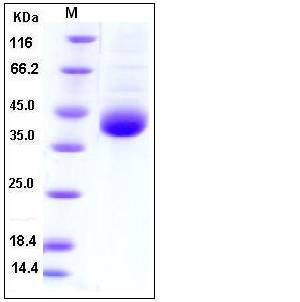Human KLK11 / Kallikrein-11 Protein (His Tag)
PRSS20,TLSP
- 100ug (NPP2295) Please inquiry
| Catalog Number | P10767-H08H |
|---|---|
| Organism Species | Human |
| Host | Human Cells |
| Synonyms | PRSS20,TLSP |
| Molecular Weight | The secreted recombinant human KLKL11 comprises 243 amino acids with a predicted molecular mass of 27 kDa. As a result of glycosylation, rhKLK11 migrates as an approximately 40 kDa band in SDS-PAGE under reducing conditions. |
| predicted N | Glu 19 |
| SDS-PAGE |  |
| Purity | > 90 % as determined by SDS-PAGE |
| Protein Construction | A DNA sequence encoding the human KLK11 isoform 1 (NP_006844.1) (Met 1-Asn 250) with a C-terminal polyhistidine tag was expressed. |
| Bio-activity | Measured by its ability to cleave a colorimetric peptide substrate D-Val-Leu-Lys-ThioBenzyl ester (VLK-SBzl), in the presence of 5,5'Dithio-bis (2-nitrobenzoic acid) (DTNB) (Edwards, K.M. et al.,1999, J. Biol. Chem. 274: 30468) . The specific activity is >200 pmoles/min/μg. (Activation description: The proenzyme needs to be activated by Thermolysin for an activated form) |
| Research Area | Cancer |Invasion microenvironment |Adhesion molecule |Extracelluar matrix |Extracellualr matrix proteases & regulators |Kallikrein / kinin | |
| Formulation | Lyophilized from sterile PBS, pH 7.4 1. Normally 5 % - 8 % trehalose, mannitol and 0.01% Tween80 are added as protectants before lyophilization. Specific concentrations are included in the hardcopy of COA. |
| Background | kallikrein-related peptidase 11 (KLK11), also known as hippostasin, trypsin-like serine protease and PRSS20, is a member of human tissue kallikrein family. It is a subgroup of serine proteases with diverse physiological functions, which is implicated in carcinogenesis and some with potential that serving as novel biomarkers for ovarian and prostate cancer and other diseases. The KLK11 gene is one of the fifteen kallikrein subfamily members located in a cluster on chromosome 19. Two alternatively spliced forms exist, resulting in 250 (isoform 1) and 282 (isoform 2) amino acid sequences. Isoform 2 is identical to isoform 1, except for an inserted 32 amino acid segment. Isoform 1 is predominantly expressed in brain whereas isoform 2 is preferentially expressed in prostate. |
| Reference |
